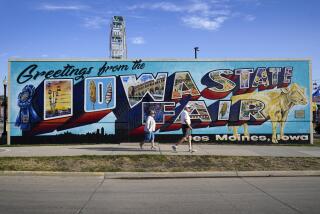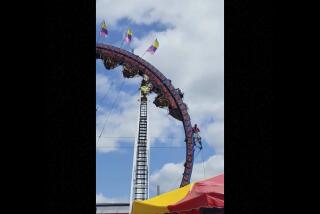Vacationing With Teen-Ager on Wisconsin Farm
- Share via
NEW GLARUS, Wis. — “Do they have gel in Wisconsin?” my Southern California born and raised teen-age daughter asked apprehensively.
She was packing for our vacation on a dairy farm. Perhaps I had made a mistake. For the first venture out of her native state, I wanted her to see the real Midwest. If there are dude ranches, I reasoned, why not dude dairies.
An inquiry to the Department of Development brought a packet of information on the best ways to “Escape to Wisconsin:” events, scenic attractions and where to eat and stay, including farm accommodations.
I chose as our escape for the week Bill and Eloise Kuenzi’s 350-acre dairy farm 21 miles south of Madison. After leaving my freshman son at the University of Wisconsin, we navigated a tangle of freeways to Interstate 90 and were immediately in the open countryside.
We drove through rolling hills of alfalfa, timothy and quack grass, punctuated by tracts of tasseled corn. Occasional herds of Holstein and Brown Swiss were sauntering toward distant barns for the evening milking.
“Does corn grow underground?” inquired Miss Sun ‘n’ Surf. I jammed my foot on the accelerator. It was time to get to the farm.
We were welcomed by 8-year-old Rhoda, who gave us a tour of the guest house, which was attached to the family’s century-old homestead. Formerly the hired hands’ quarters, it has been remodeled by Eloise and decorated with family handicrafts.
“My grandma made this quilt,” our little guide explained as we surveyed the master bedroom. “That’s Aunt Hulga’s lace nightgown hanging on the wall. Uncle Jim carved that footstool. Come into the children’s bedroom, everything in there’s mine. I painted the picture at school.”
The two-story, pine-paneled house comfortably sleeps eight. The bedrooms have cathedral ceilings and there is wall-to-wall carpeting throughout. Downstairs an ample living room overlooks fields in the east and south forty.
The sun shines warmly into the breakfast nook in the corner of the spacious kitchen, which is fully equipped with fridge and freezer, self-cleaning stove and stainless steel double sinks. There is even a paperback copy of “The Joy of Cooking” in the cupboard.
The full bath with shower and tub adjoin a laundry room, which is available to guests.
Time for Evening Milking
We had arrived in time for the evening milking. Rhoda’s big sister Mary, the milkmaid, offered to let us help. She was leaving for college in Florida that weekend, her chores to be assumed by a younger brother. Two older brothers have also left the farm, an increasingly similar trend in the region. Notices for impending house, herd and property auctions appear frequently.
“Thank heavens, Dale’s father didn’t live to see this,” Eloise said of a neighbor’s 500 acres that were to go on the block soon. “His grandfather cut the timber on that place and every one of their kids was born there.”
Milking on the Kuenzi farm is a semi-automated process. Stainless steel cylinders are attached to the udders and the milk is siphoned through plastic tubes to a huge vat in a room just off the barn. A tanker truck from the processing plant comes daily to collect it.
“Ask any questions you want,” offered Mary, setting the tone for the stay. At Bills Hills you are welcome to help with the chores; join the family in an old-fashioned pastime, conversation or stroll alone to the ridge and watch the deer darting from one thicket of trees to the other.
When I returned from the milking barn, the house was dotted with bouquets of wildflowers in jelly glasses. “A lot of them are weeds, but they’re so pretty,” mused Rhoda, who had shown my daughter her favorite escapes.
The cornfield was an apartment house, and she had led her through the “front door” into the center of the sighing, swaying stalks. There was no question in her mind now as to whether corn was a root vegetable.
Litter of Kittens
They had climbed into the hayloft and discovered a new litter of white kittens. There was another family under the trough beside the silo. They had crawled into the hutches where the calves are housed after birthing. They had rolled under the electric fence into the pasture but had second thoughts when the bull snorted and shook the ring in his nose.
What really sent them scurrying was a low, growing sound. “That’s a badger--they’re mean,” Rhoda warned. Local legend has it a badger once ate a person.
It was hard to believe that this was the same breed as UW’s lovable mascot, Bucky Badger.
We had a barbecue of brats, as bratwurst is fondly called in Wisconsin. It comes in varieties of pork and veal and is grilled slowly and ceremoniously. We laced them with Green County sweet hot mustard, on hard rolls, and lettuce picked from the garden beside our porch.
It was very dark outside, although the sky was sprayed with stars and a nearly full moon was rising. But we felt safe when we climbed upstairs, turned out the lights and went to bed. We weren’t alone. The house seemed to be occupied--with Aunt Hulga and grandma and Uncle Jim and generations of hardy Wisconsin farm pioneers.
Outside, the faithful guard dog, Bria, kept watch. A docile-looking German shepherd, she had just enough coyote in her to aggravate an occasional low moan when the coyotes began howling in the far-off forests.
Sound of Tractor
It was the muffled purring of the tractor that awoke me the next morning. Bill and a neighbor were pulling a wagon of freshly cut grass to the harvester.
I pulled on jeans, low yellow rubber boots and a warm Go-Big-Red sweat shirt. It had rained wildly during the night and when I opened the front door, I was greeted by a rush of freshly cleaned cool air.
I drove seven miles down the paved country road to New Glarus; and I was in Switzerland. New Glarus was settled nearly 150 years ago by immigrants from Glarnerland, who delighted in this rich valley so like their Alpine homeland.
Today the village is one of the top five tourist attractions in the state. Visitors are drawn especially by festivals honoring two Swiss favorites: Heidi Craft and Food Fair and Play, the last weekend in June, and the Wilhelm Tell Drama, Labor Day weekend.
Chalet architecture predominates the main streets, including a glockenspiel hanging outside the Bank of New Glarus. There are several hotels and excellent restaurants. Traditional Swiss and German menus have acculturated to include the Wisconsin custom of serving a fruit sorbet in white wine to clear the palate between the salad and main courses.
Swiss Dirndls
It is not unusual to see women in brightly colored Swiss dirndls on the main street. A fine time of the day to be in town is about dusk when sausage is smoking at the packing house and a tantalizing mesquite aroma hovers in the air.
I had breakfast of freshly baked gipfel (a Swiss croissant), sweet cream cheese and hot chocolate, bought some cold cuts and cheese for a picnic and went back to the farm.
We had missed the 5 a.m. milking, as we were to every day of our stay. We took out a map and studied some of the points of interest to explore within easy driving distance of Bills Hills. We decided to hike the Sugar River Trail.
Afterward we ate cheese and sausage sandwiches at Blue Mounds, which also offers hiking, biking and cross-country skiing in the winter. There is downhill skiing at the nearby Tyrol Basin.
We spent the afternoon in Spring Green, where Frank Lloyd Wright built his home and architectural school, Taliesin. Today visitors also marvel at the House on the Rock, a multilevel residence perched 450 feet above the Wyoming Valley.
Tomorrow or the next day we would look into the antique and gift shops of Mr. Horeb (Little Norway) or Shake Rag Alley (Mineral Point), a restoration of the homes and businesses of the Cornish craftsmen who settled there in the 1830s.
But then it was getting late. The sun was beginning to redden as we caught sight of Bills Hills. We turned off County Highway J and onto the gravel Kuenzi Lane. Mary was coming out of the milking barn. My daughter waved and called, “Thanks for lending me the gel!”
She had become a traveler.
Wisconsin Department of Development, Division of Tourism, 123 W. Washington Ave., P.O. Box 7606, Madison, Wis. 53707, (800) ESCAPES.
Bills Hills Guest House, Box 512, New Glarus, Wis. 53574, (608) 527-2840. $50 a day, weekly and long-term rates available; no credit cards.
In New Glarus: Chalet Landhaus Motel, Wisconsin 69, (608) 527-5234, $27-$72; New Glarus Hotel, 100 6th Ave., (608) 527-5244, $26-$40; Swiss-Aire Motel, 1200 Wisconsin 69 and 39, (608) 527-2138, $32-$38.
More to Read
Sign up for The Wild
We’ll help you find the best places to hike, bike and run, as well as the perfect silent spots for meditation and yoga.
You may occasionally receive promotional content from the Los Angeles Times.






